The Roman Curia comprises the administrative institutions of the Holy See and the central body through which the affairs of the Catholic Church are conducted. It acts in the pope's name and with his authority for the good and for the service of the particular churches and provides the central organization for the church to advance its objectives.

Giuseppe Pizzardo was an Italian cardinal of the Catholic Church who served as prefect of the Congregation for Seminaries and Universities from 1939 to 1968, and secretary of the Holy Office from 1951 to 1959. Pizzardo was elevated to the cardinalate in 1937.

Pietro Gasparri, GCTE was a Roman Catholic cardinal, diplomat and politician in the Roman Curia and the signatory of the Lateran Pacts. He served also as Cardinal Secretary of State under Popes Benedict XV and Pope Pius XI.

Riccardo Galeazzi-Lisi was an Italian medical doctor who served as Pope Pius XII's personal physician from 1939 until his dismissal in 1958. During his service in the Vatican he was officially titled "Archiatra Pontificio". The pope also made him an honorary member of the Pontifical Academy of Sciences. He managed to be present at the 1958 death of Pius XII and created a scandal in this context with his attempt to publish pictures and stories about the dying pontiff. He was also a member of the International Society for the History of Medicine.
The Secretariat of State is the oldest dicastery in the Roman Curia, the central papal governing bureaucracy of the Catholic Church. It is headed by the Cardinal Secretary of State and performs all the political and diplomatic functions of the Holy See. The Secretariat is divided into three sections, the Section for General Affairs, the Section for Relations with States, and, since 2017, the Section for Diplomatic Staff.
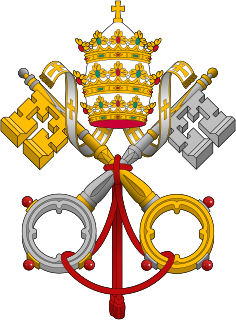
The Pontifical Academy of Sciences is a scientific academy of the Vatican City, established in 1936 by Pope Pius XI. Its aim is to promote the progress of the mathematical, physical, and natural sciences and the study of related epistemological problems., founded in 1847 as a more closely supervised successor to the Accademia dei Lincei established in Rome in 1603 by the learned Roman Prince, Federico Cesi (1585–1630), who was a young botanist and naturalist, and which claimed Galileo Galilei as its president. The Accademia dei Lincei survives as a wholly separate institution.

The Pontifical Oriental Institute (Orientale), is a Catholic institution of higher education located in Rome. The plan of creating a school of higher learning for Eastern Christianity had been on the agenda of the Catholic Church since at least Pope Leo XIII, but it was only realized in 1917 by Pope Benedict XV (1914-1921). The Orientale forms part of the consortium of the Pontifical Gregorian University and the Pontifical Biblical Institute, both in Rome. All three institutions are run by the Society of Jesus (Jesuits). While the Orientale depends on the Holy See, its management is entrusted to the Society of Jesus. Its Chancellor is the Prefect of the Congregation for the Eastern Churches and its Vice-chancellor is the Superior General of the Society of Jesus, while the Congregation for Catholic Education is the dicastery competent for approving the academic programmes of the Orientale.
The Dicastery for Legislative Texts, formerly named Pontifical Council for Legislative Texts, is a dicastery of the Roman Curia. It is distinct from the highest tribunal or court in the Church, which is the Supreme Tribunal of the Apostolic Signatura, and does not have law-making authority to the degree the Pope and the Holy See's tribunals do. Its charge is the interpretation of existing canon laws, and it works closely with the Signatura and the other Tribunals and the Pope. Like the Signatura and the other two final appellate Tribunals, the Roman Rota and the Apostolic Penitentiary, it is led by a prefect who is a bishop or archbishop.
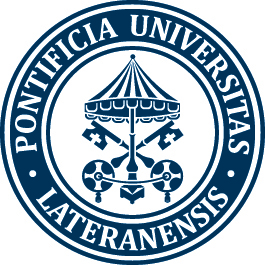
The Pontifical Lateran University, also known as Lateranum, is a pontifical university based in Rome. The university also hosts the central session of the Pontifical John Paul II Institute for Studies on Marriage and Family. The university is known as "The Pope's University". Its Grand Chancellor is the Vicar General to the Holy Father for the Diocese of Rome. Four of its graduates have been canonized. As of 2014 the Pontifical Lateran university had students from more than a hundred countries. It is also sometimes also known as the Pontifical University of Apollinaire.
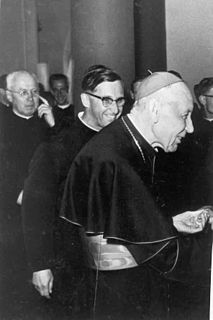
Augustin Bea, S.J., was a German Jesuit priest, cardinal, and scholar at the Pontifical Gregorian University, specialising in biblical studies and biblical archaeology. He also served as the personal confessor of Pope Pius XII.

Valerio Valeri was an Italian Cardinal of the Catholic Church. He served as Prefect of the Sacred Congregation for Religious in the Roman Curia from 1953 until his death, and was elevated to the cardinalate in 1953 by Pope Pius XII.

Gaetano Cicognani was an Italian cardinal of the Catholic Church. He served as prefect of the Apostolic Signatura from 1954 until his death, and was elevated to the cardinalate in 1953 by Pope Pius XII. To date, he and his brother, Amleto Giovanni Cicognani, are the last pair of brothers to serve simultaneously in the College of Cardinals.
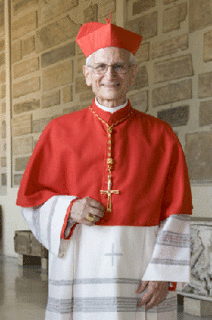
Raffaele Farina SDB is an Italian cardinal of the Catholic Church. He was Archivist of the Vatican Secret Archives, Librarian of the Vatican Library, and president of Scuola Vaticana di Paleografia, Diplomatica e Archivistica. Farina was elevated to the cardinalate in 2007.
The Pontifical Council for Social Communications was a dicastery of the Roman Curia that was suppressed in March 2016 and merged into the Secretariat for Communications.

The Pontifical Swiss Guard is a minor armed force and honour guard unit maintained by the Holy See that protects the pope and the Apostolic Palace within the territory of the Vatican City. Established in 1506 under Pope Julius II, the Pontifical Swiss Guard is among the oldest military units in continuous operation.
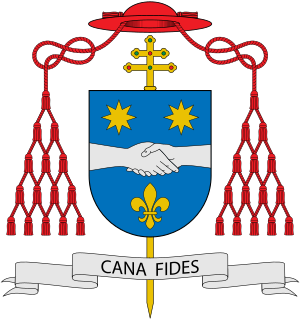
Francesco Borgongini Duca was an Italian cardinal of the Catholic Church who served as Apostolic Nuncio to Italy from 1929 to 1953 and was made a cardinal in 1953 by Pope Pius XII.

The history of the Roman Curia, the administrative apparatus responsible for managing the affairs of the Holy See and the Catholic Church, can be traced to the 11th century when informal methods of administration began to take on a more organized structure and eventual a bureaucratic form. The Curia has undergone a series of renewals and reforms, including a major overhaul following the loss of the Papal States, which fundamentally altered the range and nature of the Curia's responsibilities, removing many of an entirely secular nature.

Ralph Leo Hayes was an American prelate of the Roman Catholic Church. He served as the fourth bishop of the Diocese of Helena in Montana from 1933 to 1935, and as the fifth bishop of the Diocese of Davenport in Iowa from 1944 to 1966.

The Antonianum, also known as the Pontifical University of Saint Anthony, and as Pontifical Athenaeum Antonianum, is a Franciscan pontifical university in Rome founded in honour of Anthony of Padua. It is located in the Rione Esquiline, a block north of the Basilica of St John Lateran, at Via Merulana 124, near the intersection of Via Labicana/Viale Manzoni and Via Merulana.
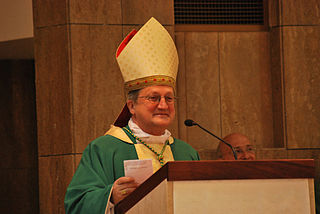
Enrico dal Covolo SDB is a Catholic bishop and Italian theologian, Assessor of the Pontifical Committee for Historical Sciences from 15 January 2019. He previously served as the rector of the Pontifical Lateran University from his appointment on 30 June 2010 until 2 June 2018. In addition he was also the postulator of the cause of canonization of Pope John Paul I from 2003 until 2016.















